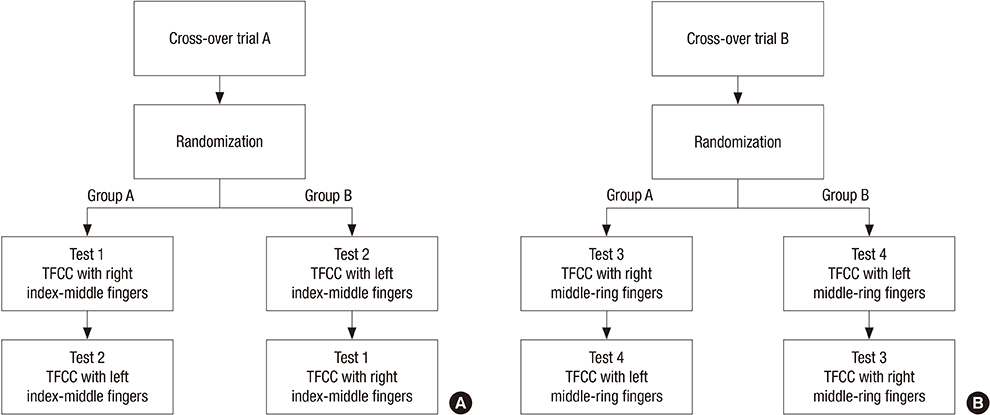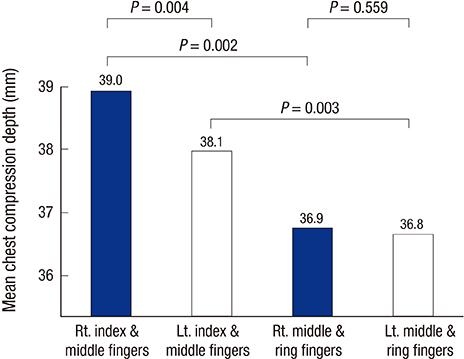J Korean Med Sci.
2016 Jun;31(6):997-1002. 10.3346/jkms.2016.31.6.997.
Which Fingers Should We Perform Two-Finger Chest Compression Technique with When Performing Cardiopulmonary Resuscitation on an Infant in Cardiac Arrest?
- Affiliations
-
- 1Department of Emergency Medicine, College of Medicine, Chung-Ang University, Seoul, Korea. jehyeok.oh@gmail.com
- KMID: 2373712
- DOI: http://doi.org/10.3346/jkms.2016.31.6.997
Abstract
- This study compared the effectiveness two-finger chest compression technique (TFCC) performed using the right vs. left hand and the index-middle vs. middle-ring fingers. Four different finger/hand combinations were tested randomly in 30 healthcare providers performing TFCC (Test 1: the right index-middle fingers; Test 2: the left index-middle fingers; Test 3: the right middle-ring fingers; Test 4: the left middle-ring fingers) using two cross-over trials. The "patient" was a 3-month-old-infant-sized manikin. Each experiment consisted of cardiopulmonary resuscitation (CPR) consisting of 2 minutes of 30:2 compression: ventilation performed by one rescuer on a manikin lying on the floor as if in cardiac arrest. Ventilations were performed using the mouth-to-mouth method. Compression and ventilation data were collected during the tests. The mean compression depth (MCD) was significantly greater in TFCC performed with the index-middle fingers than with the middle-ring fingers regardless of the hand (95% confidence intervals; right hand: 37.8-40.2 vs. 35.2-38.6 mm, P = 0.002; left hand: 36.9-39.2 vs. 35.5-38.1 mm, P = 0.003). A deeper MCD was achieved with the index-middle fingers of the right versus the left hand (P = 0.004). The ratio of sufficiently deep compressions showed the same patterns. There were no significant differences in the other data. The best performance of TFCC in simulated 30:2 compression: ventilation CPR performed by one rescuer on an infant in cardiac arrest lying on the floor was obtained using the index-middle fingers of the right hand. Clinical Trial Registry at the Clinical Research Information Service (KCT0001515).
Keyword
MeSH Terms
Figure
Reference
-
1. Maconochie IK, Bingham R, Eich C, López-Herce J, Rodríguez-Núñez A, Rajka T, Van de Voorde P, Zideman DA, Biarent D. Paediatric life support section Collaborators. European Resuscitation Council Guidelines for resuscitation 2015: section 6. Paediatric life support. Resuscitation. 2015; 95:223–248.2. Maier GW, Tyson GS Jr, Olsen CO, Kernstein KH, Davis JW, Conn EH, Sabiston DC Jr, Rankin JS. The physiology of external cardiac massage: high-impulse cardiopulmonary resuscitation. Circulation. 1984; 70:86–101.3. Ozcan A, Tulum Z, Pinar L, Başkurt F. Comparison of pressure pain threshold, grip strength,dexterity and touch pressure of dominant and non-dominant hands within and between right-and left-handed subjects. J Korean Med Sci. 2004; 19:874–878.4. Hogrel JY. Grip strength measured by high precision dynamometry in healthy subjects from 5 to 80 years. BMC Musculoskelet Disord. 2015; 16:139.5. Brown SG, Roy EA, Rohr LE, Bryden PJ. Using hand performance measures to predict handedness. Laterality. 2006; 11:1–14.6. RANDOM.ORG (IE). Random sequence generator [Internet]. accessed on 22 April 2015. Available at http://www.random.org/sequences/.7. Martin PS, Kemp AM, Theobald PS, Maguire SA, Jones MD. Do chest compressions during simulated infant CPR comply with international recommendations? Arch Dis Child. 2013; 98:576–581.8. Centre for Clinical Research and Biostatistics (HK). Sample size estimation [Internet]. accessed on 22 April 2015. Available at http://www2.ccrb.cuhk.edu.hk/stat/Means.htm.9. Menegazzi JJ, Auble TE, Nicklas KA, Hosack GM, Rack L, Goode JS. Two-thumb versus two-finger chest compression during CRP in a swine infant model of cardiac arrest. Ann Emerg Med. 1993; 22:240–243.10. Houri PK, Frank LR, Menegazzi JJ, Taylor R. A randomized, controlled trial of two-thumb vs two-finger chest compression in a swine infant model of cardiac arrest. [see comment]. Prehosp Emerg Care. 1997; 1:65–67.11. Dorfsman ML, Menegazzi JJ, Wadas RJ, Auble TE. Two-thumb vs. two-finger chest compression in an infant model of prolonged cardiopulmonary resuscitation. Acad Emerg Med. 2000; 7:1077–1082.12. Whitelaw CC, Slywka B, Goldsmith LJ. Comparison of a two-finger versus two-thumb method for chest compressions by healthcare providers in an infant mechanical model. Resuscitation. 2000; 43:213–216.13. Haque IU, Udassi JP, Udassi S, Theriaque DW, Shuster JJ, Zaritsky AL. Chest compression quality and rescuer fatigue with increased compression to ventilation ratio during single rescuer pediatric CPR. Resuscitation. 2008; 79:82–89.14. Udassi JP, Udassi S, Theriaque DW, Shuster JJ, Zaritsky AL, Haque IU. Effect of alternative chest compression techniques in infant and child on rescuer performance. Pediatr Crit Care Med. 2009; 10:328–333.15. Udassi S, Udassi JP, Lamb MA, Theriaque DW, Shuster JJ, Zaritsky AL, Haque IU. Two-thumb technique is superior to two-finger technique during lone rescuer infant manikin CPR. Resuscitation. 2010; 81:712–717.16. Christman C, Hemway RJ, Wyckoff MH, Perlman JM. The two-thumb is superior to the two-finger method for administering chest compressions in a manikin model of neonatal resuscitation. Arch Dis Child Fetal Neonatal Ed. 2011; 96:F99–101.17. Huynh TK, Hemway RJ, Perlman JM. The two-thumb technique using an elevated surface is preferable for teaching infant cardiopulmonary resuscitation. J Pediatr. 2012; 161:658–661.18. Saini SS, Gupta N, Kumar P, Bhalla AK, Kaur H. A comparison of two-fingers technique and two-thumbs encircling hands technique of chest compression in neonates. J Perinatol. 2012; 32:690–694.19. Jo CH, Jung HS, Cho GC, Oh YJ. Over-the-head two-thumb encircling technique as an alternative to the two-finger technique in the in-hospital infant cardiac arrest setting: a randomised crossover simulation study. Emerg Med J. 2015; 32:703–707.20. Jiang J, Zou Y, Shi W, Zhu Y, Tao R, Jiang Y, Lu Y, Tong J. Two-thumb-encircling hands technique is more advisable than 2-finger technique when lone rescuer performs cardiopulmonary resuscitation on infant manikin. Am J Emerg Med. 2015; 33:531–534.21. Berg MD, Schexnayder SM, Chameides L, Terry M, Donoghue A, Hickey RW, Berg RA, Sutton RM, Hazinski MF; American Heart Association. Pediatric basic life support: 2010 American Heart Association Guidelines for cardiopulmonary resuscitation and emergency cardiovascular care. Pediatrics. 2010; 126:e1345–60.22. MacDermid JC, Lee A, Richards RS, Roth JH. Individual finger strength: are the ulnar digits “powerful”? J Hand Ther. 2004; 17:364–367.
- Full Text Links
- Actions
-
Cited
- CITED
-
- Close
- Share
- Similar articles
-
- Effects of chest compression only cardiopulmonary resuscitation training on retention of correct cardiopulmonary resuscitation knowledge
- Comparison of CPR Outcomes between Autopulse TM and Manual Compression in Adult Out-of-hospital Cardiac Arrest
- Cardiopulmonary Resuscitation: New Concept
- The Mechanism of Blood Flow Generation during Closed Chest Cardiac Massage: Transesophageal Echocardiographic Monitoring
- Analysis of the Performance for Bystanders; Cardiopulmonary Resuscitation in Geriatric and Out-of-Hospital Cardiac Arrested Patients




